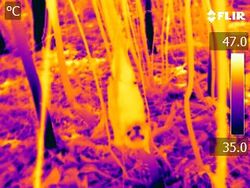Biology:Australian flying fox die-offs
In the last two decades tens of thousands of Australian flying foxes have died during extreme heat events.[1] Flying fox die-offs feature arguably among the most dramatic mass mortality events witnessed in nature, but they can be indicators of heat stress in more cryptic fauna where impacts are more difficult to assess. The die-offs are important additional threats to Australian flying-foxes and the ecosystem services they provide, and highlight the complex implications of climate change for behaviour, demography, and species survival.
Impacts on species
Two Australian flying fox species have reportedly been affected by extreme heat events: the grey-headed flying fox (Pteropus poliocephalus) and the black flying fox (P. alecto). Where mixed-species colonies are affected the black flying fox suffers substantially higher mortality than the grey-headed flying fox.[1] However, summer temperatures are more extreme within the range of the grey-headed flying fox than within the range of the black flying-fox, and therefore the actual total number of casualties is much higher among grey-headed flying foxes than black flying foxes. On occasion, the federally endangered spectacled flying fox (Pteropus conspicillatus) may be affected as well, further threatening the species in Australia.
Impacts on demography
Mortality is especially high among dependent young and lactating females, but any demographic category can be affected.[1]
Impacts on behaviour
Observations in flying fox colonies during extreme heat events have revealed that flying foxes go through a predictable sequence of thermoregulatory behaviours with rising temperatures:[1]
- wing-fanning
- shade-seeking and clustering
- panting
- salivation
Beyond this, individuals tend to be found near the bases of trees where they form piles of lethargic and dead bats.
List of recorded Australian flying fox die-offs
| Event | Date | State | Area | Number of camps affected | Minimum mortality estimate | Maximum mortality estimate | Species affected | Source |
|---|---|---|---|---|---|---|---|---|
| 1 | February 1791 | NSW | Sydney | grey-headed flying fox | Tench 1793[1][2] | |||
| 2 | December 1905 | NSW | Helidon | grey-headed flying fox | Ratcliffe, 1932[1][3] | |||
| 3 | January 1913 | NSW | Mallanganee | grey-headed flying fox | Ratcliffe, 1932[1][3] | |||
| 4 | January 1994 | Qld | Townsville and Ipswich | 2 | 1000 | grey-headed flying fox, black flying fox | Welbergen et al., 2008[4] | |
| 5 | December 1994 | NSW | Cabramatta and Gordon | 2 | 6000 | 6000 | grey-headed flying fox | Welbergen et al., 2008[4] |
| 6 | late 1900s | NT | 1 | 29 | 29 | grey-headed flying fox | Tidemann & Nelson 2011[4] | |
| 7 | January 2000 | Qld | Ipswich | 500 | 500 | grey-headed flying fox, black flying fox | Welbergen et al., 2008[4] | |
| 8 | 12 January 2002 | NSW | Murwillumbah | 9 | 3679 | grey-headed flying fox, black flying fox | Welbergen, Klose et al., 2008[4] | |
| 9 | January 2003 | NSW | Cabramatta and Gordon | 2 | 5000 | 5000 | grey-headed flying fox | Welbergen et al., 2008[4] |
| 10 | January 2004 | NSW | Bellingen | 1 | 3000 | 8000 | grey-headed flying fox | Welbergen et al., 2008[4] |
| 11 | December 2004 | NSW | Coff's Harbour | 2 | 1000 | 5000 | grey-headed flying fox | Welbergen et al., 2008[4] |
| 12 | December 2005 | Qld, NSW, Vic | 3 | 5613 | 8900 | grey-headed flying fox, black flying fox | Welbergen et al., 2008[4] | |
| 13 | January 2006 | NSW, Vic | 6 | 4273 | 4843 | grey-headed flying fox | Welbergen et al., 2008[4] | |
| 14 | December 2006 to January 2007 | Vic | Melbourne | 2 | 207 | 207 | grey-headed flying fox | Welbergen et al., 2008[4] |
| 15 | January 2014 | Qld | >25 | 100000 | grey-headed flying fox, black flying fox | Murphy 2014, Saunders 2014[4] | ||
| 16 | November 2014 | NSW | Casino and Richmond Valley | 2 | 7000 | 7000 | grey-headed flying fox, black flying fox | Godfrey 2014[4] |
| 17 | November 2018 | Qld | 33000 | 40000 | spectacled flying fox, black flying fox | [5] | ||
| 18 | December 2019 | Vic | Melbourne | 4500 | grey-headed flying fox | [6][7] |
References
- ↑ 1.0 1.1 1.2 1.3 1.4 1.5 1.6 Justin A. Welbergen; Stefan M. Klose; Nicola Markus; Peggy Eby (2008). "Climate change and the effects of temperature extremes on Australian flying-foxes". Proceedings of the Royal Society B: Biological Sciences 275 (1633): 419–425. doi:10.1098/rspb.2007.1385. PMID 18048286.
- ↑ Tench, Watkin (1793). Complete account of the settlement at Port Jackson; Including An Accurate Description of the Situation of the Colony; of the Natives; and of Its Natural Productions. London: G. Nicol and J. Sewell. http://setis.library.usyd.edu.au/ozlit/pdf/p00044.pdf.
- ↑ 3.0 3.1 Francis Ratcliffe (1932). "Notes on the fruit bats (Pteropus spp.) of Australia". Journal of Animal Ecology 1 (1): 32–57. doi:10.2307/993.
- ↑ 4.00 4.01 4.02 4.03 4.04 4.05 4.06 4.07 4.08 4.09 4.10 4.11 4.12 Thomas J. O'Shea; Paul M. Cryan; David T.S. Hayman; Raina K. Plowright; Daniel G. Streicker (2016). "Multiple mortality events in bats: a global review". Mammal Review 46 (3): 175–190. doi:10.1111/mam.12064. PMID 29755179.
- ↑ "How one heatwave killed 'a third' of a bat species in Australia". BBC News. 15 January 2019. https://www.bbc.com/news/world-australia-46859000.
- ↑ "Flying foxes are dying en masse in Australia's extreme heat" (in en). 7 January 2020. https://www.nationalgeographic.com/animals/2020/01/flying-foxes-are-dying-en-masse-in-australias-extreme-heat/.
- ↑ "Heat stress and the Australian flying fox". 24 January 2020. https://www.bbc.com/news/in-pictures-51191849.
External links
| Wikimedia Commons has media related to Pteropus poliocephalus. |
- ARKive – images and movies of the grey-headed flying-fox (Pteropus poliocephalus)
- Background: P. poliocephalus
- Brief history of Megachiroptera / Megabats
Template:Heat wave Template:Pteropodidae
 |


